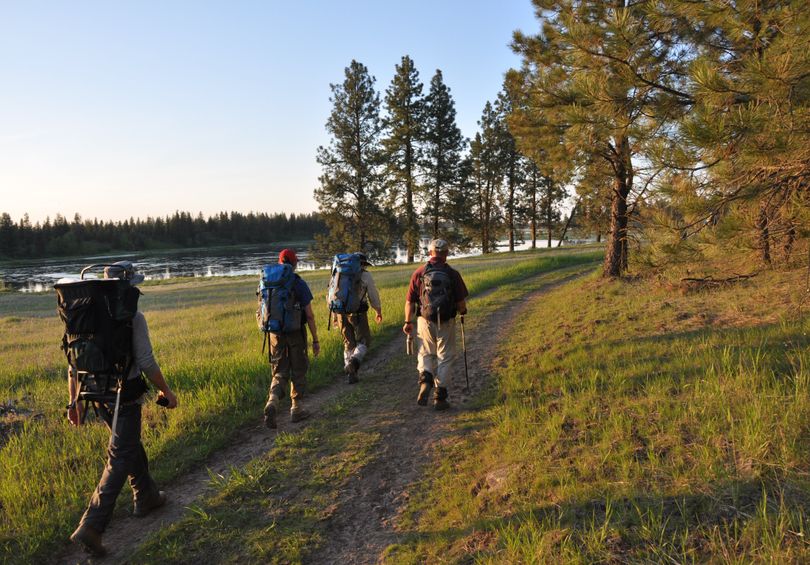Don’t be creeped out by ticks; be proactive


CREEPY CRITTERS -- With a local girl being diagnosied with Rocky Mountain spotted fever, it's worthwhile for outdoors enthusiasts to reup our precautions against tick bites.
Following is my Thursday column on ticks and precautions against tick bites. However, the following blog version includes numerous links for more information about tick-borne diseases, treatments and precautions.
Read on to check it out.
Ticks have taught me a thing or two about:
- The quantity and quality time one can have with the family hunting dog after a spring training romp through tick country.
- The similarities between a close-companion tick check and foreplay.
Dr. Phil, Howard Stern and I will be coauthoring a book about this soon.
Meantime, tick encounters also have a serious side, emphasized last week when Rocky Mountain spotted fever was diagnosed in a 6-year-old Spokane girl who had not recently been out of the general area.
The Spokane Regional Health District on Monday urged precautions against ticks in their various stages of life, even though tick-borne diseases are extremely rare in this area.
Up to three cases a year of Rocky Mountain spotted fever have been reported in this region, officials said, although the number is more likely to be zero. Only five cases of tick paralysis have been reported in 20 years, the press release says.
Relapsing fever – it comes and goes, as the name implies – is more common in Eastern Washington and North Idaho, although often not diagnosed, other experts say.
Indeed, the Spokane area is infamous in medical literature for having the largest episode of relapsing fever recorded in the United States.
In 1969 during a campout on Browne Mountain, 11 of 42 Boy Scouts and leaders were infected. Ten of 20 Scouts who spent the night in an old cabin contracted the disease, while only one of 22 who camped out in tents was infected, according to a report in the Journal of the American Medical Association.
The wood tick that causes Rocky Mountain spotted fever, lives in natural areas. The relapsing tick is more closely related to rodent nests.
Cabins are prime places to come in contact with the relapsing fever tick. Here's how to protect against it.
A relative of the young girl being treated for Rocky Mountain spotted fever – a potentially fatal illness – said her parents plucked two hard-shelled ticks from her skin. Soon she developed at least some of the classic symptoms of tick-borne illness, which include fever, rash, headache, nausea, abdominal pain, muscle pain, red eyes, lack of appetite and red eyes.
She is responding to treatment with tetracycline, but that’s an indicator of how seriously doctors are treating the illness. Tetracycline is effective against the disease in its early stages, but it’s likely to cause streaking in the enamel of a child’s permanent teeth.
While most creatures have a role beneficial to another species, ticks appear to have no other purpose than to torment warm-blooded animals, including us.
No birds, insects or reptiles eat them for nutrition, experts tell me.
Ticks suck, and that’s about the best you can say about them.
But ticks shouldn’t deter people who love hiking and camping in the outdoors.
I’ve had epic experiences with these menacing arachnids in certain spring hot spots, such as the Slavin Conservation Area south of Spokane, the Crab Creek area in Lincoln County and the Desert Lakes area near Moses Lake – where I caught five trout in one day and harvested more than 160 ticks off my Brittany spaniel.
Ticks like to cruise a body for hours before finding a spot to attach. I routinely change clothes when I return home and check my body and scalp. If I find ticks, they’re almost always unattached.
If one is attached, I use my finger tips to pinch where the tick head meets the skin. I pull firmly but slowly – as you’d pull a nightcrawler from its hole in the lawn – until the head and intact mouthparts pull painlessly loose, usually with little bits of white skin stuck in its “teeth.”
Then I wash the wound with soap and water and disinfect.
The Health District recommends using tweezers, but vets and ER docs I know use their fingers in the field.
Avoid home remedies, such as touching the tick with a match or applying petroleum jelly, which can promote infection, local Health officials say on a good one-page brochure on dealing with ticks.
Preventing ticks from getting on your skin is an even better strategy.
Before going hiking, consider using Permethrin to treat the lower leg of your pant, the collar and sleeve cuffs of your shirt (I always wear long-sleeve shirts while hiking and fishing for bug and sun protection). Treated hats are very helpful, too.
DEET repellent is effective, but I generally prefer Permethrin because it’s applied to clothing rather than skin. Check here for a report on DEET vs. Permethrin.
Permethrin is the insecticide used in Buzz-Off brand clothing. Our family buys it by the spray bottle to treat our clothing.
My wife, Meredith, treats bandanas with Permethrin, which she puts in every family member’s pack when we go for an outing to ward off ticks and mosquitoes. We wear them over our heads or around our necks as the situation dictates.
Since I’m happily married, I don’t have to be self conscious about adopting a nerdy look: tucking pant legs into socks and wearing light-colored, long-sleeve shirts with collars to help deny ticks access to my skin.
If you wear convertible hiking pants, check the flap of material that covers the zipper of the removable pant legs when you end your hike. Ticks hooking onto your pant often will crawl up and snuggle under that flap, which I’ve dubbed the “tick trap.”
My friend, David Moershel, found nine ticks in the “tick trap” of one pant leg after a fly-fishing hike up Crab Creek one year.
At home, take time to check yourself and your dog again.
A partner is especially helpful when checking your back and hair.
It can be an especially soothing experience with the right companion.
A couple glasses of Merlot can make it even better.
